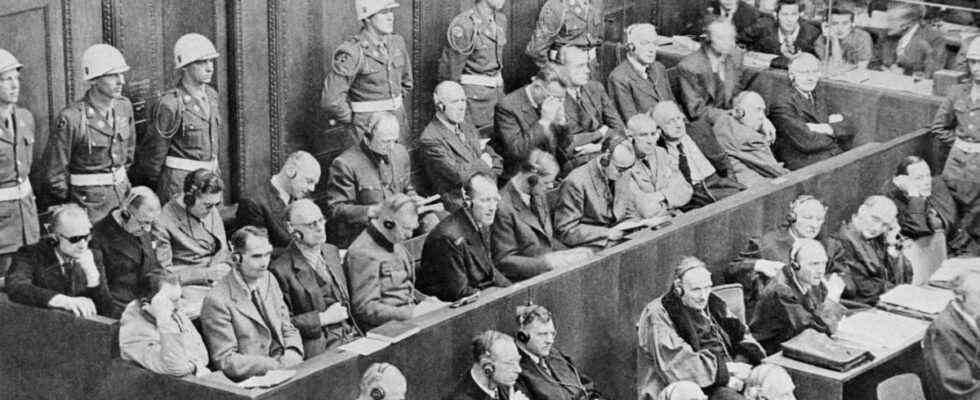When the crimes of the National Socialists were to be dealt with at the Nuremberg Trials in 1945/6, interpreting became a central medium for this processing. The remaining heads of the Nazi dictatorship had to answer for their actions before an international military tribunal. For the tribunal of the four victorious powers, the statements of both the perpetrators and the witnesses had to be interpreted into the four official languages of the trial – English, French, Russian and German.
The previously established form of consecutive interpreting would have taken too much time and delays could have given the perpetrators an advantage in “preparing” their statements. In order to speed up communication, the recently developed simultaneous translation, i.e. translation almost in real time, was used in Nuremberg for the first time. For this, the International Business Machines Corporation, now commonly known as IBM, provided the technical equipment.
The light signals from the interpreters controlled the flow of speech of the speakers
This is exactly where the solo exhibition “The Witness-Machine Complex” by Turner Prize winner Lawrence Abu Hamdan at the Nürnberger Kunstverein starts. The artist picks up the yellow and red lightbulbs on the historic microphone desks and re-animates them. The simultaneous interpreters, men and women, used the flashing lights to communicate with the defendants, witnesses, experts and prosecutors during the ongoing trial. More precisely, the light signals controlled their flow of speech: The one-time brief flashing of the yellow light bulb asked them to slow down their speaking speed, three flashes asked them to speak louder, and if something was not understood, the red light signal indicated the need to to repeat the last statement in each case.
Invisible power in the negotiating room of a historic trial.
(Photo: Lukas Pürmayr)
In a darkened room, Abu Hamdan positions seven steel stands, each supporting a gray cuboid. LED lamps are screwed into these, imitating the yellow and red light bulbs. Recordings of the testimony of witnesses such as Jakob Grigorjewitsch Grigorjew and Marie-Claude Vaillant-Couturier can be heard from these blocks – they are also loudspeakers – their transcripts and translations are projected onto the wall. But also Nazi greats like the Reich Economics Minister and Reichsbank President Walther Funk have their say via audio document. Funk had robbed Jews by seizing their property after they were murdered in the concentration camp.
Using the footage of the Nuremberg Trial, the artist reconstructs how the light signals controlled or interrupted the speech of the process participants, sometimes throwing the witnesses off the track. Those shifts in pitch and pace of speech, the smallest uncertainties in voice and mood, which have remained undocumented in the written down of the procedure, can thus be experienced again.
Please speak: Abu Hamdan revived the technology from 1945.
(Photo: Lukas Pürmayr)
Interrupted by the flashing light, the French resistance fighter and Auschwitz survivor Vaillant-Couturier is forced to slow down her speech. In a kind of slow staccato, she speaks about atrocities committed by the Nazis. Grigoryev, whose village Kuznetsovo was wiped out by German soldiers in October 1943 and from which he himself was only able to escape with great difficulty, falls silent when the light flashes. Even when the court tells him to continue, he can hardly break his own silence.
This revival of technology from 1945 makes it clear that the transcripts of the procedure with their lexical, syntactic and semantic accuracy only suggest coherent speaking – and not only make the space for the inexpressible and inexpressible disappear, but also the traces of the translation technology blur yourself.
IBM’s technology is revealed as an invisible force in the negotiating room of this historic trial. IBM wasn’t neutral anyway. It was not until 2001 that the investigative journalist Edwin Black proved that the German IBM subsidiary Dehomag supplied the Nazis with punched card technology that was also used to perpetrate the Holocaust. If the Nazis ignored the light signals of the translation equipment on the witness stand, they still seemed to claim their hegemony over the technology, even as the defendants – while the same technology seemed to dehumanize the victims one more time.
His work has the evidential value of a forensic plea: Lawrence Abu Hamdan.
(Photo: Stuart C. Wilson / Getty)
Lawrence Abu Hamdan’s research-intensive work, which has the evidential value of a forensic plea, begins with acoustic investigations; the artist sees himself as a “sound detective” (private ear). With the hearings and interrogations of the Nuremberg Trials, he puts himself and thus also the audience in the role of an investigative and at the same time empathetic listener. Even more than 75 years after the Nuremberg Trials, the contradicting complex of technology, power and violence can be experienced in all its depressingly current explosiveness.
Lawrence Abu Hamdan, The Witness-Machine Complex at the Kunstverein Nürnberg. Until December 19th.

